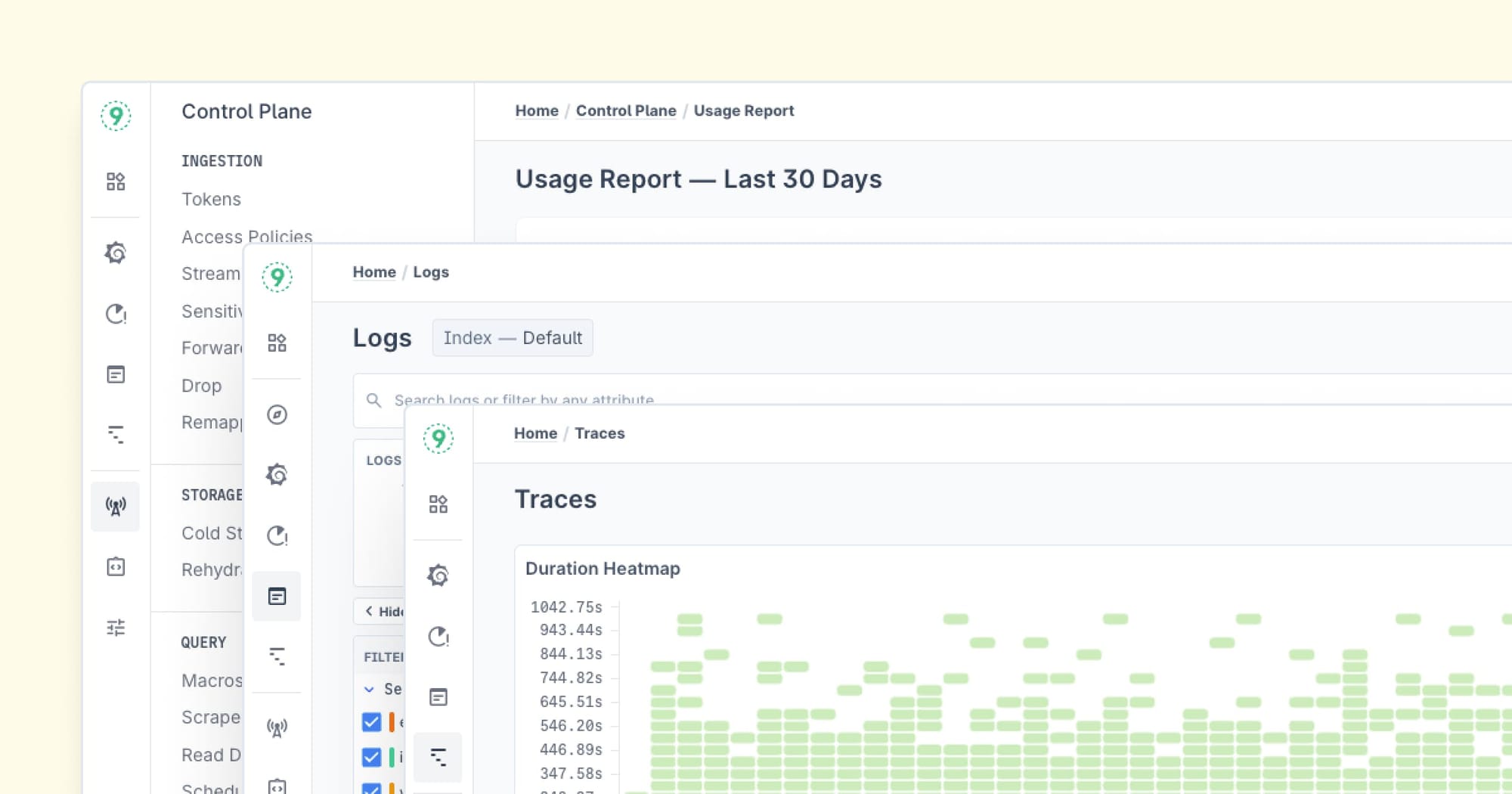Effective observability is crucial now more than ever as teams deal with the complexities of microservices, containers, and distributed systems. The demand for real-time insights to quickly diagnose and fix issues has never been higher.
One tool that’s making waves in this area is eBPF (extended Berkeley Packet Filter). It’s gaining traction fast because of its ability to provide deep visibility without causing significant performance overhead.
In this blog, we’ll take a closer look at what eBPF is, how it works, and why it's changing observability.
What is eBPF?
eBPF is a kernel technology that lets you run sandboxed programs directly in the operating system kernel, all without needing to change the kernel code itself.
Created for packet filtering, eBPF has evolved into a versatile tool that can monitor system calls, trace functions, gather performance metrics, and even enforce custom network policies.
At its core, eBPF allows programs to run in response to events happening in the kernel, without the need for complicated instrumentation. This makes it lightweight and powerful for observability, offering insights that traditional monitoring tools often couldn’t provide.

Optimizing Systems with the Observability Maturity Model
How eBPF Improves Observability
1. Deep Visibility with Minimal Overhead
eBPF allows you to monitor your systems at a granular level, from the kernel to the application layer.
Unlike traditional agents that require deep instrumentation, eBPF operates at the kernel level, reducing the impact on performance.
This means you can get detailed metrics and trace data without sacrificing speed or efficiency.
2. Real-time Monitoring and Tracing
One of the standout features of eBPF is its ability to capture real-time events across your systems. Tracking system calls, function execution, or network traffic, eBPF programs provide a continuous stream of insights into system behavior.
This allows for fast identification of anomalies, helping teams resolve issues quickly before they escalate.
3. Full Stack Observability
eBPF’s flexibility makes it ideal for monitoring all layers of a system. From network traffic and application performance to low-level kernel operations, eBPF enables you to collect a wide variety of data.
This full-stack observability is crucial for understanding complex microservices architectures, as it helps correlate different metrics to build a comprehensive picture of your system’s health.

Full-Stack Observability for Better Application Performance
4. Custom Instrumentation
With eBPF, you can create custom monitoring tools tailored to your specific needs.
Building an observability platform or enhancing an existing solution becomes significantly more flexible with eBPF. It empowers teams to add custom probes and tracepoints directly into their workflows, all without the need to modify the existing codebase.
This adaptability makes it an invaluable asset for teams with unique or evolving observability requirements.
eBPF vs. Traditional Monitoring Tools
Traditional monitoring solutions usually rely on agents installed on hosts or containers to collect data. While these tools can give you a solid look at system performance, they come with some drawbacks.
For one, they can introduce overhead, require regular updates, and might not provide the depth of visibility you need when troubleshooting complex issues.
That’s where eBPF steps in. It operates at the kernel level, offering a lighter, more efficient alternative that doesn’t slow things down.

OpenTelemetry vs. Traditional APM Tools
Key Benefits of eBPF Over Traditional Monitoring Tools
- Lower overhead: Since eBPF runs directly in the kernel, there’s no need for extra agents or instrumentation, which means less strain on your system.
- Better granularity: eBPF gives you a much finer look at system events—think function calls, memory usage, and network traffic—allowing you to monitor things in much greater detail.
- Dynamic instrumentation: With eBPF, you can load programs on the fly. That means you can update things in real time and add new probes without having to restart services.
Integrating eBPF with Existing Observability Tools
eBPF isn’t meant to replace observability tools like Prometheus or OpenTelemetry; it works alongside them to add an extra layer of visibility. Integrating eBPF with these tools enhances your observability stack, providing richer data to help you better understand system health and performance.
Here’s how eBPF complements existing tools:
- Low-level metrics: eBPF can provide detailed, low-level metrics that can be aggregated and visualized in tools like Grafana.
- Alerting integration: These metrics can also feed into alerting systems, helping to trigger automated responses when potential issues arise.
- Enhanced tracing and metrics: When paired with OpenTelemetry, eBPF boosts the tracing and metrics collection process, offering deeper insights into system behavior.

Top Observability Best Practices for Microservices in 2024
eBPF’s Relevance for Platform Teams and Application Developers
eBPF is changing the game for platform teams and application developers when it comes to observability, performance tuning, and security. Integrating eBPF into their workflows unlocks deeper insights into both applications and infrastructure, even in production environments.
Here’s why eBPF is quickly becoming a must-have tool for them:
1. Real-Time Observability
eBPF provides unmatched, low-overhead visibility into system behavior by working directly at the kernel level. This gives teams the power to:
- Track system calls and kernel events that impact performance.
- Monitor resource usage like CPU, memory, and disk to spot inefficient code or misconfigurations.
- Trace application metrics and follow requests across distributed systems, helping identify bottlenecks and failures.
The best part? You get instant insights without relying on delayed signals like logs, so issues can be detected and resolved faster.
2. Simplified Troubleshooting in Production
For developers, debugging production issues often feel like chasing ghosts. eBPF changes that, offering real-time debugging without the need for heavy instrumentation or trying to reproduce issues locally. It excels at tasks like:
- Tracing latency by analyzing function calls and the time spent in different parts of the application.
- Diagnosing errors in system calls, network traffic, or inter-process communication that might slip past traditional logging.
- Gaining a clear, real-world view of system behavior, cutting down on the guesswork in complex environments.

Last9’s Single Pane for High Cardinality Observability
3. Performance Optimization Made Easy
Managing infrastructure or optimizing application code, eBPF offers granular insights to:
- Detect resource hogs, such as memory leaks or CPU-intensive processes.
- Monitor and optimize slow queries, reducing application response times.
- Minimize profiling overhead while still pinpointing root causes of performance degradation.
This means smoother operations for platform teams and faster, leaner applications for developers.
4. Strengthened Security Monitoring
Security is as much about observation as prevention, and eBPF excels here too. Its kernel-level capabilities help:
- Spot malicious activities like unauthorized file access or abnormal system calls.
- Enforce security policies by identifying suspicious system behaviors.
- Protect containerized environments by analyzing potential vulnerabilities in traffic, system calls, or resource usage.
With eBPF, developers can bake security into applications, while platform teams stay ahead of threats in real-time.

Why Golden Signals Matter for Monitoring
5. Custom Observability for Unique Needs
eBPF’s flexibility is its superpower. Teams can design custom probes to monitor exactly what matters most to their environments, enabling:
- Tailored monitoring of unique application behaviors or system metrics.
- Seamless integration with tools like Prometheus and Grafana to enhance existing observability stacks.
- Precise control over monitored data, avoiding unnecessary overhead while maintaining deep insights.
This approach ensures no blind spots, offering visibility where off-the-shelf tools might fall short.
6. Faster Development and Troubleshooting Cycles
By removing bottlenecks in debugging and improving observability, eBPF accelerates the entire development lifecycle:
- Real-time issue identification reduces time wasted on log analysis and guesswork.
- Proactive problem detection allows teams to fix potential issues before they impact users.
- Simplified workflows lead to faster deployments, fewer production hiccups, and happier end users.
In short, eBPF isn’t just a tool—it’s an enabler for building robust, high-performing software at speed.
eBPF Adoption and Implementation Across Industries
As organizations embrace cloud-native technologies, eBPF has become a vital tool for observability and troubleshooting in production environments.
Its lightweight nature and powerful monitoring capabilities make it an attractive choice for optimizing system performance, security, and reliability.
Let’s understand how eBPF is making an impact across various industries:
Tech and SaaS Companies
Tech and SaaS companies were among the first to adopt eBPF, using it to gain deeper insights into distributed systems. With eBPF, they can monitor microservices, trace user requests, and pinpoint performance bottlenecks in real time.
In the competitive SaaS landscape, where uptime and responsiveness are critical, eBPF helps maintain high performance while minimizing system overhead.
Financial Services
Security and performance are paramount in the financial industry, and eBPF delivers on both fronts.
Providing real-time visibility into system behavior, financial institutions can detect fraud, identify latency issues, and ensure regulatory compliance.
eBPF’s low-latency monitoring and secure data collection make it invaluable for high-stakes environments handling high-frequency transactions.
E-Commerce and Retail
For e-commerce platforms, particularly during high-traffic events like Black Friday, performance and uptime are everything.
eBPF helps monitor infrastructure health, analyze resource usage, and resolve issues like slow page loads or failed transactions before they affect customers. This proactive approach enhances user experience, even during peak demand.

Telecommunications
Telecom providers rely on eBPF for monitoring packet flows, detecting network anomalies, and diagnosing issues like congestion or packet loss.
This enables faster resolution times and improved service reliability, ensuring uninterrupted connectivity—an essential for customer satisfaction in this industry.
Healthcare
Healthcare organizations are using eBPF to monitor IT infrastructures like patient data systems and medical device networks.
With real-time performance insights, healthcare providers can ensure smooth operations and detect unusual patterns that might indicate security threats or system failures.
eBPF’s low-impact monitoring also helps maintain compliance with privacy regulations, safeguarding sensitive data.
Gaming
In the gaming industry, eBPF is enhancing the performance and user experience of online and multiplayer games.
Monitoring network traffic, tracing server performance, and identifying issues like packet loss or lag allows gaming companies to deliver smooth gameplay, ensuring player satisfaction and quick issue resolution.
Cloud and Hosting Providers
Cloud service providers are embracing eBPF to enhance observability across vast, dynamic infrastructures.
eBPF provides deep visibility into network and host systems, offering insights into resource usage, load balancing, and downtime reduction.
For multi-tenant environments, eBPF’s telemetry and tracing capabilities simplify troubleshooting in complex setups.

A Guide to Database Optimization for High Traffic
Manufacturing and IoT
As IoT adoption grows in manufacturing, eBPF is becoming indispensable for monitoring connected devices.
It enables real-time insights into sensor data, machine performance, and network traffic, helping reduce downtime and improve predictive maintenance.
Additionally, eBPF enhances security by detecting potential breaches or unauthorized access to critical systems.
Practical Use Cases of eBPF in System Observability
eBPF's versatility makes it applicable in a wide range of observability scenarios, each offering unique advantages.
Here are some key use cases where eBPF can significantly enhance system monitoring:
Performance Monitoring
eBPF enables granular monitoring of system resources, allowing you to track CPU usage, memory consumption, disk I/O, and network throughput at a fine level of detail.
Capturing real-time performance data with eBPF helps identify bottlenecks or resource hogs within the system, enabling proactive performance optimization without adding significant overhead.
Distributed Tracing
eBPF excels at tracing requests as they move through a distributed system.
It allows teams to track the lifecycle of a request as it passes between services, identifying latencies and failures that are difficult to detect with traditional monitoring tools.
Visualizing service dependencies and response times with eBPF enables efficient troubleshooting and helps optimize the overall architecture.
Network Observability
With eBPF, you can gain deep visibility into network traffic, capturing detailed data on packet flows, connection statuses, and protocol usage.
This visibility is crucial for diagnosing network-related issues, whether it’s identifying dropped packets, slow connections, or anomalous traffic patterns.
It also helps in detecting potential security threats, such as DDoS attacks or unauthorized data transfers.
Security Monitoring
eBPF can be used to monitor system calls and detect unusual or unauthorized activities. For instance, eBPF can track access patterns to sensitive files or monitor abnormal system behavior that might indicate a security breach.
Capturing and analyzing low-level events, eBPF provides real-time alerts for potential vulnerabilities or exploit attempts, making it a vital tool for enhancing system security.

Why Cloud Security Monitoring is Crucial for Your Business
Container and Kubernetes Monitoring
In containerized environments like Kubernetes, eBPF provides visibility into the inner workings of containers without the need to install agents within them.
Monitoring system calls and resource usage on a per-container basis, eBPF helps teams track how containers interact with each other and the underlying infrastructure, facilitating performance troubleshooting and improving system reliability.
Custom Observability Tools
One of the strengths of eBPF is its flexibility. Teams can create custom probes for specific metrics or events, providing highly specialized observability that traditional tools may not cover.
eBPF can be adapted to track specific function calls or monitor unique network protocols, making it ideal for teams with unique observability needs.
Latency Analysis
eBPF can be employed to monitor the latency at every stage of a process, from kernel to user space.
Tracing function calls and network requests allows teams to pinpoint the components causing delays. This visibility is crucial for optimizing performance in time-sensitive applications, ensuring that latency bottlenecks are detected and resolved in real-time.

Tail Latency: Key in Large-Scale Distributed Systems
System Resource Allocation
eBPF also provides insights into how system resources are allocated and utilized by different processes.
Analyzing CPU scheduling, memory allocation, or disk access with eBPF allows teams to track resource consumption over time and correlate it with system behavior. This helps in understanding resource utilization patterns and ensuring that system resources are distributed optimally.
Challenges and Considerations
While eBPF offers immense power and flexibility, it comes with its own set of challenges. For teams new to this technology, writing and debugging eBPF programs can be complex.
Additionally, environments requiring kernel-level access may not always be compatible with eBPF, such as certain managed environments or older systems.
Another critical consideration is optimizing eBPF programs to avoid unnecessary overhead.
While eBPF is designed to be lightweight, poorly written programs can introduce performance bottlenecks. This makes careful implementation and rigorous testing essential to fully harness its capabilities.

Everything about API Monitoring
Community and Educational Resources for eBPF
The eBPF world is growing fast, and there’s no shortage of great resources to help you level up your skills—whether you’re a beginner or a seasoned pro.
If you’re into kernel modules, network events, or eBPF-based workloads, there’s something here for you.
Here are some great places to learn, connect, and stay in the loop with eBPF:
1. eBPF Summit
Think of the eBPF Summit as the ultimate yearly meetup for eBPF enthusiasts. It’s packed with expert talks, cutting-edge use cases, and plenty of best practices related to kernel space and runtime performance.
If you can’t attend in person, there are many sessions available online, making it a go-to resource for keeping up with the latest and greatest in eBPF observability.
2. The eBPF Project GitHub
If you like your learning hands-on, the eBPF GitHub is a treasure trove. It’s got everything from official code and tools to documentation and tutorials.
If you're looking to experiment, contribute, or build custom programs, this is the ideal place to begin.
3. BPF Compiler Collection (BCC)
The BPF Compiler Collection simplifies the magic of eBPF, offering tools for performance tuning and troubleshooting.
The BCC GitHub repository is packed with examples and guides—perfect for developers wanting to put eBPF to work in real-world scenarios.
4. eBPF in Action (Book)
Written by Brendan Gregg, a well-known expert in performance analysis, eBPF in Action is a comprehensive guide that covers both the basics and more advanced topics like tracing, networking, and security.
It’s a great resource for anyone looking to deepen their understanding of eBPF.

Logging Errors in Go with ZeroLog
5. eBPF.io
eBPF.io is your one-stop shop for all things eBPF. It’s got everything: tutorials, documentation, blogs, and links to community resources. Whether you’re dipping your toes or need in-depth technical guides, you’ll find what you’re looking for here.
6. eBPF Slack Channel
The eBPF Slack channel is a lively space where the community connects. It’s a great place to ask questions, share experiences, and learn from others in real-time, making it perfect for both newcomers and experienced users.
7. Tutorials and Blogs
Blogs and tutorials bring eBPF to life through practical examples.
Check out resources like Brendan Gregg’s blog and Linux Observability by Aravind Putrevu for deep dives into real-world scenarios.
8. Online Courses and Webinars
Prefer structured learning? Platforms like these have you covered:
- Linux Foundation Training: Offers professional courses, including Linux kernel and eBPF essentials.
- Udemy: Features courses catering to both beginners and advanced users.
- YouTube: A treasure chest of eBPF tutorials, summit talks, and demos.
9. eBPF Weekly Newsletter
Stay in the know with the eBPF Weekly Newsletter. It’s your curated digest of tools, blog posts, and updates, helping you keep a finger on the pulse of the eBPF ecosystem.
10. Online Communities and Forums
For Q&A and general geekery, check out forums like:
- Stack Overflow: Perfect for technical questions and solutions.
- Reddit (r/linux): Great for discussions and tips from fellow developers.

Crontab Logs: Track, Debug, and Optimize Your Cron Jobs
Conclusion
eBPF has transformed how we approach observability, security, and performance optimization. Its ability to deliver granular insights with minimal overhead makes it a vital tool for teams navigating the challenges of distributed systems.
FAQs
What is eBPF, and how does it work?
eBPF (extended Berkeley Packet Filter) is a technology that allows programs to run safely in the Linux kernel. It enables real-time data collection and system behavior analysis without modifying kernel code.
Why is eBPF useful for observability?
eBPF provides detailed visibility into system calls, network traffic, and application performance, all with minimal overhead. This level of insight helps teams troubleshoot, optimize, and secure their systems more effectively.
Do I need to modify my applications to use eBPF?
No, eBPF operates at the kernel level and doesn’t require changes to your application code. It works seamlessly across the system, providing insights without disrupting your workflows.
Can eBPF be used in production environments?
Absolutely. eBPF is designed for real-time monitoring and debugging in production. It allows developers to collect data, trace functions, and diagnose issues without impacting application performance.
How does eBPF enhance system security?
eBPF monitors system calls, network activity, and process behaviors, enabling teams to detect and respond to abnormal patterns or potential threats in real time.
Where can I find learning resources for eBPF?
Start with the eBPF.io website, GitHub repositories, and resources like eBPF in Action by Brendan Gregg. You can also explore tutorials, webinars, and community discussions to deepen your knowledge.
Does eBPF work only on Linux?
Currently, eBPF is primarily supported on Linux systems. However, its growing popularity has spurred efforts to expand its capabilities to other platforms.
How do I start using eBPF?
Begin with tools like the BPF Compiler Collection (BCC) or explore the eBPF GitHub repositories for code examples and tutorials. Joining community forums and Slack channels is also a great way to learn and collaborate.















